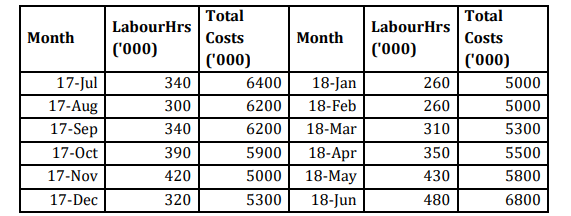
MAASAI MARA UNIVERSITY
REGULAR UNIVERSITY EXAMINATIONS
2019/2020 ACADEMIC YEAR
FOURTH YEAR FIRST SEMESTER
SCHOOL OF BUSINESS AND ECONOMICS
BACHELOR OF COMMERCE
COURSE CODE: BCM 4104
COURSE TITLE: MANAGERIAL ACCOUNTING
DATE: 11TH DECEMBER 2019 TIME: 1100 – 1300 HRS
INSTRUCTIONS TO CANDIDATES
1. Answer Question ONE and any other THREE questions
2. Do NOT write on this Question paper
This paper consists of 5 printed pages. Please turn over.
QUESTION ONE
Chuma Moto prepares its budget for the year every 30th June. In relation to
total costs, the company estimates that the labour hours influence the level of
total costs (y=a+bx; y-total costs, a – fixed costs, b – is the variable cost per
unit and x – level of activity). The following data relates to the year ending 30th

Required:
a) Estimate the cost function of the company using:
i) High-low method (4 marks)
ii)Linear regression (4 marks)
b) Calculate the total costs in the following situations if 550 labour hours are
used (2 marks)
c) If the company incurs total costs of sh. 10,000,000 estimate the labour
hours applied (2 marks)
d) Aberdeen Company Ltd. is a manufacturing company which produces and
sells a single product known as Tumbo1 at a price of Sh.10 per unit. The
company incurs a variable cost of Sh.6 per unit and fixed costs of
Sh.400,000. Sales are normally distributed with a mean of 110,000 units
and a standard deviation of 10,000 units. The company is considering
producing a second product, Tumbo2 to sell at Sh.8 per unit and incur a
variable cost of Sh.5 per unit with additional fixed costs of Sh.50,000. The
demand for Tumbo2 is also normally distributed with a mean of 50,000
units and standard deviation of 5,000 units. If Tumbo2 is added to the
production schedule, sales of Tumbo1 will shift downwards to a mean of
85,000 units and standard deviation of 8,000 units. The correlation
coefficient between sales of Tumbo1 and Tumbo2 is –0.9.
Required:
i) The company’s break-even point for the current and proposed production
schedules (5 marks)
ii) The coefficient of variation for the two proposals. (6 marks)
iii) Based on your computation’s in (i) and (ii) above advise the company on
whether to add T2 to its production schedule. (2 marks)
QUESTION TWO
a)Standards are important in the management of costs. In respect to
standards, explain three standards that managerial accountants deal with.
(3 Marks)
b) KaramboLtd manufactures an oil product whose standard variable cost is
given below:
Direct materials (2 kg @ Sh 3) 6
Direct labour (0.75 hours @ Sh 4) 3
Variable overheads 1
The company treats fixed costs as period costs and therefore they are not
charged to products.The following information relates to the month of March
2019.
1/3/2019 31/3/2019
Sh Sh
Stocks (all at standard cost)
Raw materials 12,000 6,000
Finished goods 36,000 42,500
The following information is available for the month of March 2019:
Sh
Sales @ Sh 20 per unit 200,000
Material purchases @ Sh 3.50 per kg 42,000
Direct labour cost (8000 hours) 30,000
Variable overheads 12,000
Material price variance (adverse) 21,000
The management is wondering whether they could have performed better.
Required:Calculate the following variances in each case stating two possible
causes of the following variances:
a) Material usage variance (3 Marks)
b) Labour rate variance (3 Marks)
c) Labour efficiency variance (2 Marks)
d) Variable overhead expenditure variance (2 Marks)
e) Variable overhead efficiency variance (2 Marks)
QUESTION THREE
Due to comprehensive bargaining agreement, the wage rates for skilled
workers are to increase by 50% over the budget figures. There is a shortage of
such skilled workers and it takes over a year to train new recruits adequately.
The managing director has asked you for advice as to which order of priority
on the product range would give best use of the skilled resources available.
The cost of unskilled labour of which there is no shortage will go up by 20%
over the budget. The original budget figures for the next period before
allowing for the increase in labour cost detailed above were as follows;

Variable overheads are recovered at the rate of sh. 1 per labour hour. The
skilled labour available amounts to 30000 hours in the period and there are
fixed costs of sh. 22,800.
Required:
a)Calculate the product mix that maximizes profits (10 Marks)
b)Discuss the uses of CVP analysis to management accountants (3 Marks)
c)Differentiate between managerial accounting & cost accounting(2 Marks)
QUESTION FOUR
a) A company produces to order and carries no inventory as a result. Its
demand function is estimated to be P= 100 – 2Q (P- selling price/unit, Qquantity demanded in thousands of units)
Its cost function is estimated to be C=Q2 + 10Q + 500 (C-total cost in
thousands and Q is quantity demanded in thousands of units)
Required:
i) Calculate the output in units that will maximize total profit, calculate the
corresponding unit selling price, total profit and total sales (4 Marks)
ii) Calculate the output in units that will maximize total revenues and to
calculate the corresponding unit selling price, total loss and total sales
revenue (4 Marks)
b) The following data relates to the operations of a manufacturing
organization. The direct labour needed to make the first machine is 1000
hours and the learning curve is 80%. The direct labour cost is sh. 5 per
hour and direct materials cost sh. 1800 per machine while the fixed cost for
either size order is sh. 8000.
Required: Calculate the average unit cost of making:
i) 4 machines (2 Marks)
ii) 8 machines (2 Marks)
iii) What accounting and project management areas can learning curves
be applied? (3 Marks)
QUESTION FIVE
Clearly explain the following as used in managerial accounting. Give examples
where appropriate and be clear in your explanations.
a) Target costing (3 Marks)
b) Value chain analysis (3 Marks)
c) Learning curve (3 Marks)
d) Standard costing (3 Marks)
e) R2 (3 Marks)
